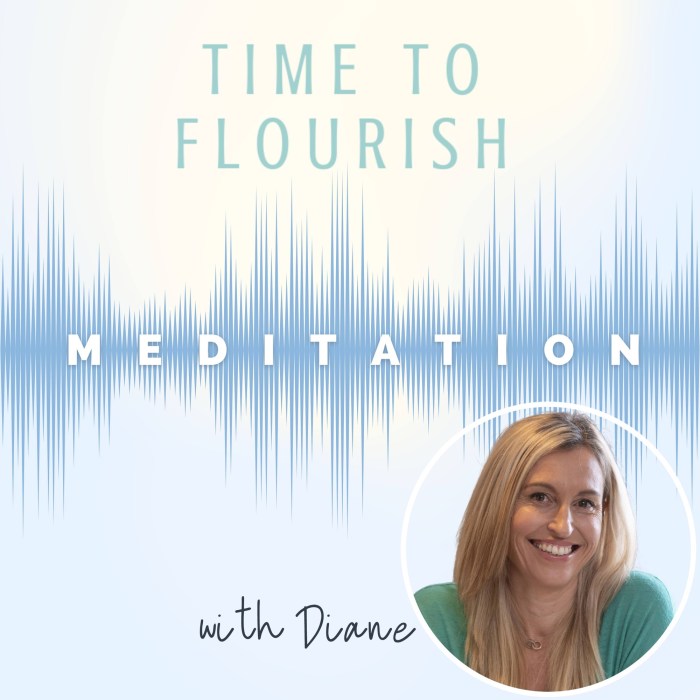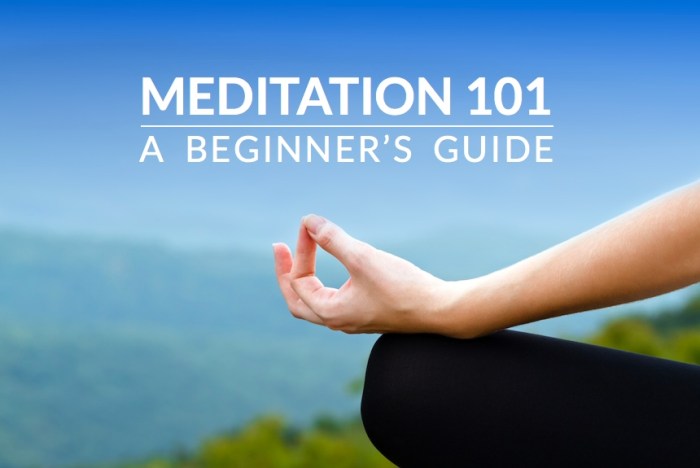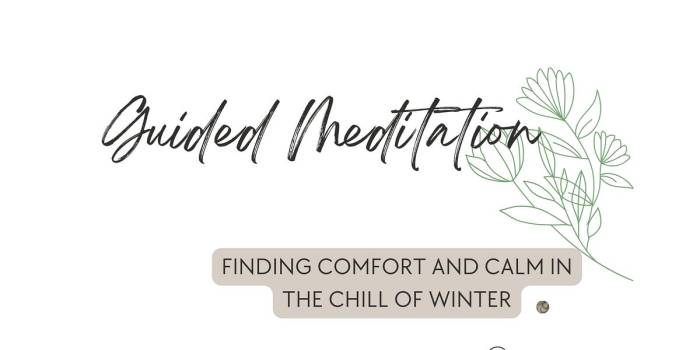With 10 Steps to Mastering Guided Meditation at the forefront, embark on a journey shrouded in mystery and intrigue. Delve into the world of guided meditation with unexpected twists and profound insights awaiting at every step.
Explore the depths of mindfulness, breathing techniques, visualization, and more as you unravel the secrets to mastering guided meditation.
Understanding Guided Meditation
Guided meditation is a practice where an individual is led through a meditation session by a trained guide, either in person or through recorded audio/video. This form of meditation helps individuals relax, focus their minds, and achieve a sense of inner peace and clarity.
Benefits of Guided Meditation
- Reduces stress and anxiety levels
- Improves focus and concentration
- Promotes better sleep and relaxation
- Enhances self-awareness and mindfulness
How Guided Meditation Differs
- Guided meditation provides structured guidance throughout the meditation session, unlike other forms where individuals meditate on their own.
- It often includes visualization techniques, breathing exercises, and body scans to deepen the meditative experience.
Popular Guided Meditation Techniques
- Body Scan Meditation: Focuses on scanning the body from head to toe, bringing awareness to each body part.
- Loving-Kindness Meditation: Involves sending love and kindness to oneself and others, fostering compassion.
- Visualization Meditation: Utilizes imagery to create a calming and peaceful mental space for relaxation.
Setting Up for Guided Meditation

Creating a comfortable meditation space is essential for a successful guided meditation session. This space should be free from distractions and conducive to relaxation.
Importance of Posture and Breathing Techniques
- Posture plays a crucial role in guided meditation as it helps in maintaining focus and alignment. Sit comfortably with your back straight but relaxed, shoulders down, and hands resting gently.
- Focus on your breathing by taking deep, slow breaths. This helps in calming the mind and body, preparing you for the meditation practice.
Tools and Props for Enhanced Experience
- Use a cushion or meditation pillow to support your lower back and hips, ensuring comfort during long meditation sessions.
- A soft blanket can provide warmth and coziness, helping you relax further during the practice.
- Incense or essential oils can create a soothing atmosphere, promoting relaxation and mindfulness.
- Soft music or nature sounds can enhance the meditation experience by masking external noises and creating a calming ambiance.
Finding the Right Guide or App
Finding the right guide or app for guided meditation is crucial for a fulfilling practice. Whether you prefer a human guide or a digital app, there are certain qualities and features to consider to ensure effective meditation sessions.
Comparing Guided Meditation Apps
When choosing a guided meditation app, consider factors such as the variety of meditation programs offered, the expertise of the instructors, user-friendly interface, customization options, and cost. Popular apps like Headspace, Calm, Insight Timer, and Buddhify offer different styles and features to cater to various preferences.
Qualities of an Effective Meditation Guide
- Experience and expertise in meditation techniques
- Clear and soothing voice for guided instructions
- Ability to create a calming and safe space for meditation
- Understanding of different meditation practices and their benefits
- Empathy and compassion towards practitioners
Tips for Choosing the Right Guided Meditation Program
- Identify your specific meditation goals and preferences.
- Read reviews and testimonials from other users to gauge the effectiveness of the program.
- Try out free trials or sample sessions before committing to a paid program.
- Consider the length and frequency of sessions that align with your schedule.
- Choose a guide or app that resonates with you on a personal level for a more meaningful practice.
Practicing Mindfulness in Guided Meditation: 10 Steps To Mastering Guided Meditation

Mindfulness plays a crucial role in guided meditation as it helps individuals stay present, focused, and aware of their thoughts, emotions, and surroundings. By practicing mindfulness during guided meditation sessions, individuals can deepen their practice and experience a greater sense of inner peace and clarity.
Techniques to Stay Present and Focused
- Focus on your breath: Pay attention to the sensations of your breath as you inhale and exhale. This can help anchor your mind in the present moment.
- Body scan: Slowly scan your body from head to toe, noticing any areas of tension or discomfort. By bringing awareness to your body, you can release physical and mental stress.
- Labeling thoughts: When thoughts arise during meditation, gently label them as “thinking” and let them go. This practice can help you detach from your thoughts and return to the present moment.
- Use guided imagery: Visualize calming scenes or scenarios suggested by the guide to engage your senses and enhance mindfulness.
Benefits of Mindfulness for Mental Well-being
- Reduced stress and anxiety: Mindfulness can help individuals manage stress and anxiety by promoting relaxation and a sense of calm.
- Improved focus and concentration: By training the mind to stay present, mindfulness can enhance focus and concentration in daily activities.
- Enhanced self-awareness: Practicing mindfulness can increase self-awareness and emotional intelligence, leading to better decision-making and relationships.
- Greater resilience: Mindfulness cultivates resilience by helping individuals navigate challenges with a sense of perspective and equanimity.
Mastering Breathing Techniques

Breathing techniques play a crucial role in guided meditation as they help in calming the mind and relaxing the body. Deep breathing can significantly impact stress reduction and promote a sense of well-being during meditation sessions.
Various Breathing Exercises
- Diaphragmatic Breathing: Focus on breathing deeply into your diaphragm, allowing your belly to rise as you inhale and fall as you exhale.
- Equal Breathing: Inhale and exhale for an equal count, such as inhaling for a count of four and exhaling for a count of four.
- 4-7-8 Breathing: Inhale for a count of four, hold the breath for a count of seven, and exhale for a count of eight.
Impact of Deep Breathing
- Deep breathing helps activate the body’s relaxation response, reducing stress hormones and promoting a state of calmness.
- It increases oxygen flow to the brain, improving focus and concentration during meditation.
Tips for Synchronizing Breath with Guided Meditation
- Listen to the guide’s cues on when to inhale and exhale, syncing your breath with their instructions.
- Focus on the rhythm of your breath and try to maintain a steady and even pace throughout the meditation session.
- Practice mindfulness by observing the sensations of your breath as you inhale and exhale, staying present in the moment.
Incorporating Visualization in Guided Meditation
Visualization is a powerful technique used in guided meditation to enhance focus, relaxation, and manifestation of goals. By creating vivid mental images, individuals can engage their senses and emotions more deeply during meditation, leading to a more immersive experience.
Examples of Visualization Practices
- For Stress Relief: Visualize a peaceful nature setting, such as a tranquil beach or a serene forest. Imagine the sound of waves, the warmth of the sun, and the gentle breeze to calm your mind and release stress.
- For Self-Confidence: Picture yourself succeeding in a challenging situation, whether it’s giving a presentation or overcoming a fear. Visualize the details of your success, including your body language, emotions, and surroundings, to boost your confidence and motivation.
Deepening the Meditation Experience with Visualization
Visualization can deepen the meditation experience by stimulating the brain’s neural pathways associated with emotions and memory. When incorporating visualization, individuals can tap into their subconscious mind, create positive mental images, and rewire their thought patterns for increased well-being and personal growth.
Exploring Body Scan Meditation
Body scan meditation is a mindfulness practice that involves systematically bringing awareness to each part of the body, from head to toe. This technique helps in grounding oneself in the present moment, releasing tension, and promoting relaxation. By focusing on each body part, individuals can cultivate a deeper connection between mind and body, leading to a sense of calm and well-being.
Step-by-Step Guide on Performing Body Scan Meditation
- Find a comfortable and quiet space to sit or lie down.
- Close your eyes and take a few deep breaths to relax.
- Start by bringing your attention to the crown of your head.
- Slowly move your focus down, acknowledging each body part one at a time.
- Notice any sensations or feelings without judgment.
- If you encounter tension or discomfort, breathe into that area and visualize releasing the tension with each exhale.
- Continue down to your toes, taking your time to scan through every part of your body.
- Once you reach the bottom, take a few more deep breaths before slowly opening your eyes.
Personal Experiences with Body Scan Meditation
Many individuals have reported feeling more relaxed, centered, and in tune with their bodies after practicing body scan meditation regularly. Some have mentioned experiencing reduced stress, improved sleep quality, and a heightened sense of self-awareness. By incorporating body scan meditation into their daily routine, people have found a valuable tool for managing anxiety and increasing overall well-being.
Overcoming Challenges in Guided Meditation
When practicing guided meditation, it is common to encounter obstacles that can hinder your progress. It is essential to identify these challenges and learn how to address them effectively. By understanding how to overcome distractions and wandering thoughts, as well as the importance of consistency and patience, you can enhance your meditation experience.
Dealing with Distractions and Wandering Thoughts
- Acknowledge distractions without judgment: Instead of trying to push away distractions, acknowledge them and let them pass without engaging with them.
- Refocus on your breath or guide: When you notice your mind wandering, gently bring your focus back to your breath or the guidance provided in the meditation.
- Practice self-compassion: Be kind to yourself when distractions arise, and gently guide your attention back to the present moment without criticism.
Importance of Consistency and Patience
- Establish a regular practice: Consistency is key in meditation, so try to set aside time each day to engage in guided meditation.
- Be patient with yourself: It is normal to face challenges in meditation, and progress takes time. Practice patience and trust the process.
- Celebrate small victories: Acknowledge and celebrate the progress you make, no matter how small, to stay motivated on your meditation journey.
Tracking Progress and Growth

Tracking progress and growth in guided meditation practice is essential to monitor your development and stay motivated on your journey towards mindfulness. It allows you to see how far you have come and identify areas for improvement.
Significance of Journaling or Reflection
Journaling or reflecting after each guided meditation session can provide valuable insights into your thoughts, emotions, and experiences during the practice. It helps you gain a deeper understanding of your inner self and track any patterns or changes over time. By jotting down your reflections, you can also celebrate small victories and recognize areas where you may need to focus more attention.
- Write down your thoughts, feelings, and sensations experienced during the meditation.
- Identify any recurring patterns or distractions that come up regularly.
- Note any improvements in your focus, relaxation, or overall well-being after each session.
Setting Goals and Milestones
Setting specific goals and milestones in your guided meditation practice can help you measure your progress and stay motivated. By establishing clear objectives, you can track your development more effectively and adjust your practice as needed to achieve your desired outcomes.
- Start by setting realistic and achievable goals for your meditation practice.
- Break down larger goals into smaller milestones to track your progress more easily.
- Regularly review and adjust your goals based on your progress and evolving needs.
Cultivating a Sustainable Practice
When it comes to integrating guided meditation into your daily routine, consistency is key. By establishing a regular practice, you can experience the full benefits of meditation and make it a lasting habit in your life.
Strategies for Integration
- Set aside a specific time each day for meditation, whether it’s in the morning before starting your day or in the evening before bed.
- Create a dedicated meditation space in your home where you can relax and focus without distractions.
- Use reminders or cues, such as alarms or calendar notifications, to help you remember to meditate daily.
Importance of Self-Compassion
Self-compassion and non-judgment are crucial in sustaining a meditation practice. It’s essential to be kind to yourself, especially on days when your mind feels restless or distracted during meditation. Embracing self-compassion allows you to accept your thoughts and emotions without criticism, fostering a more positive and nurturing practice.
Adapting to Evolving Needs, 10 Steps to Mastering Guided Meditation
- Explore different meditation techniques to find what works best for you at different stages of your life.
- Adjust the duration of your meditation sessions based on your schedule and energy levels.
- Be open to trying new approaches and incorporating mindfulness into various activities throughout your day.
Last Recap

As you reach the end of this captivating journey, reflect on the transformative power of guided meditation in fostering inner peace and mental well-being. Embrace the practice with a renewed sense of purpose and dedication, ready to navigate life’s challenges with newfound clarity and calm.